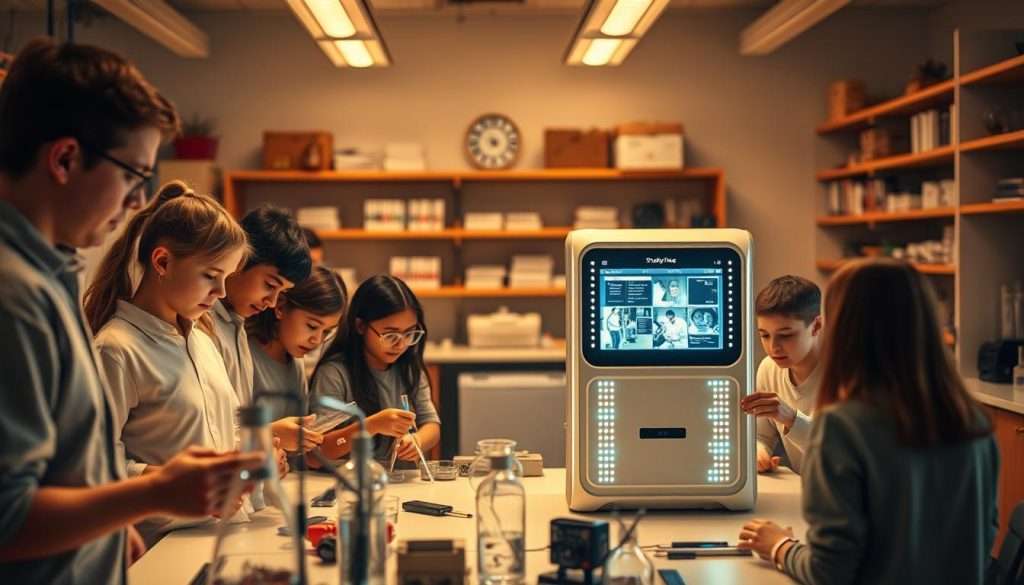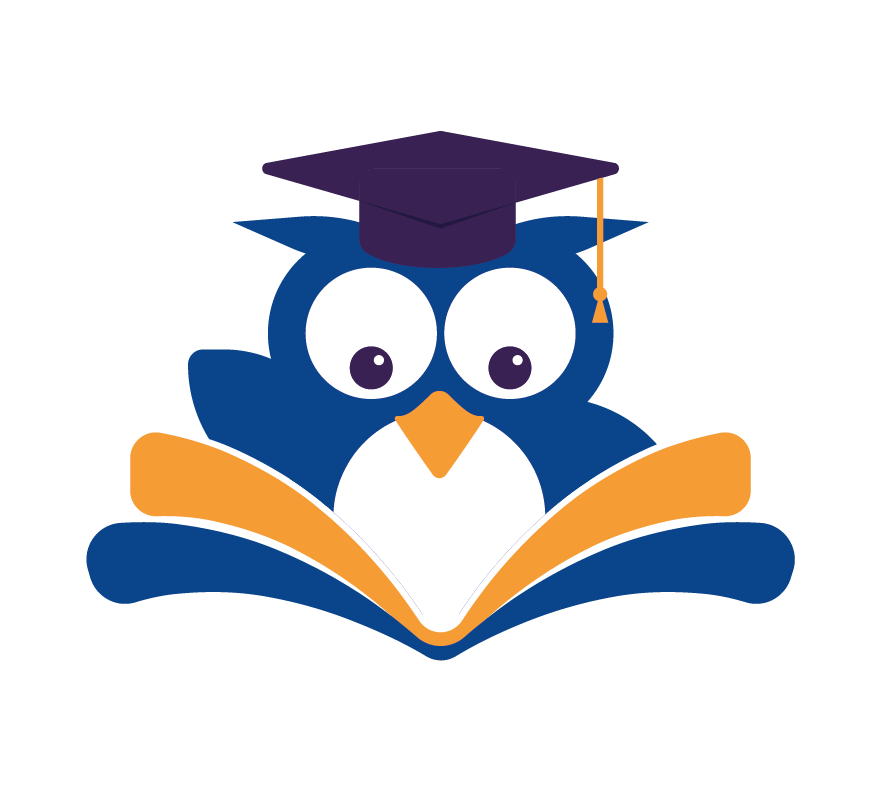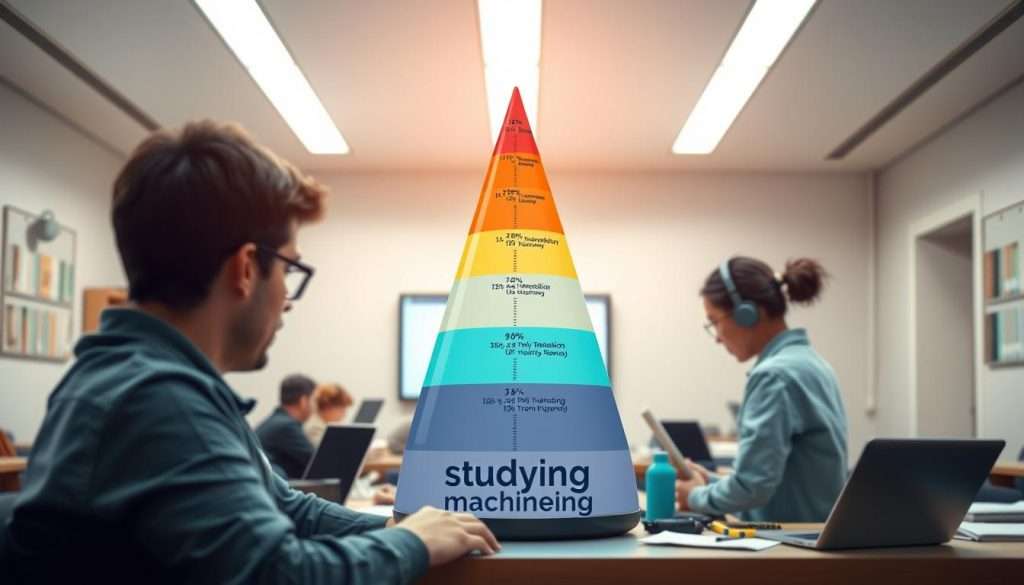Are you tired of studying hard but not retaining information? Edgar Dale’s Cone of Learning can help. This concept, developed in 1946, changed how we learn.
Dale’s idea sorts learning methods from most concrete to most abstract. This means hands-on and experiential learning is more effective.
We’re excited to explore the Cone of Learning and how it can improve your studies. By understanding this concept, you can learn smarter, not harder.
Key Takeaways
- Understand the concept of the Cone of Learning and its origin.
- Learn how to apply experiential learning to your studies.
- Discover how to retain information more effectively.
- Explore practical tips for making the most of the Cone of Learning.
- Debunk common misconceptions about learning methods.
What is the Cone of Learning?
Imagine a visual way to show how we learn. That’s the Cone of Learning. It’s a model that shows how we take in and keep information.
Definition and Basic Concept
The Cone of Learning is a tool that sorts learning into levels. It says we learn more when we do things ourselves, like hands-on activities. This idea helps teachers make learning better.
Edgar Dale’s Original Model
Edgar Dale created the ‘Cone of Experience’ in 1946. His Cone puts learning methods in order from simple to complex. It has changed over time, becoming the Cone of Learning or Learning Pyramid we know today.
Knowing where the Cone of Learning comes from helps us use it better. It shows us the power of doing things ourselves in learning. This way, we can study smarter and remember more.
The Evolution of the Learning Pyramid
The Learning Pyramid has changed a lot over time. It started with Edgar Dale’s Cone of Experience. Now, it’s known as the Learning Pyramid. Let’s look at how it has grown and what it means today.
Historical Development
Edgar Dale first showed us how people learn with the Cone of Experience. Later, it became the Learning Pyramid. These changes show we now know more about learning and keeping information.
Some big changes include:
- Adding how much we remember to the model
- Making the structure fit different learning places better
- Using new teaching ways and tech
Modern Interpretations and Research
Today, the Learning Pyramid keeps growing. Experiential learning is especially important for remembering and understanding.
Recent studies have found:
- Active learning helps us remember more
- Technology makes learning by doing easier
- We need a mix of learning methods
Knowing how the Learning Pyramid has changed helps us learn better. It shows us its good points and what it can’t do.
Understanding the Different Levels of the Cone of Learning
The Cone of Learning shows us how we learn and remember. Each level has its own way of helping us absorb information. Knowing how well we retain information at each level helps us learn better.
Passive Learning Methods
Passive learning is not as effective as active learning. Yet, it still helps us learn. Let’s look at how well we retain information through reading, hearing, and seeing.
Reading (5% Retention)
Reading is key, but it only keeps about 5% of what we learn. It’s not time to stop reading. Instead, mix it with other methods to keep more information.
Hearing (10% Retention)
Hearing or listening is another way we learn, keeping about 10% of what we hear. Lectures and audio materials work well when used with other methods.
Seeing (20% Retention)
Seeing information helps us remember more, keeping about 20% of what we see. Watching videos or presentations can really help us understand and remember.
Active Learning Methods
Active learning is where we really learn, with much better retention rates. Let’s dive into participating and doing.
Participating (50% Retention)
Getting involved in discussions or group activities boosts retention to about 50%. Being active with the material helps us understand it better.
Doing (90% Retention)
Doing what we’ve learned is the best way to remember it, with a retention rate of about 90%. Hands-on experiences are crucial for learning well.
By using the different levels of the Cone of Learning in our studies, we can learn and remember more.
The Science of Retention Rates in Experiential Learning
The science behind how we remember things in experiential learning is really interesting. It can change how we learn. Experiential learning, which includes doing things and getting your hands dirty, helps us remember better.

How Memory Formation Works
Creating memories is a complex process. It involves senses, repetition, and feeling connected. When we do things in experiential learning, our brains make strong links between new and old knowledge. This is called neuroplasticity, our brain’s ability to change with new experiences.
Studies show that when we’re involved in learning, our brains make more dopamine. Dopamine helps us remember and stay motivated. So, experiential learning not only helps us remember but also makes learning fun and rewarding.
Factors That Enhance Information Retention
So, what makes experiential learning better for remembering things? Here are some important points:
- Sensory Engagement: Using more senses (sight, sound, touch) helps us remember better.
- Repetition and Practice: The more we practice, the more we remember.
- Emotional Connection: Learning that makes us feel something is more memorable and fun.
- Feedback and Reflection: Getting feedback and thinking about what we learned helps us remember it longer.
By knowing these factors and using them in our learning, we can remember more. This makes the education model more effective.
How to Apply the Cone of Learning to Your Studies
Now that we’ve explored the Cone of Learning, let’s see how to use it to improve your studying. Learning well means doing hands-on activities, talking about what you’ve learned, and using pictures and diagrams. By using the Cone of Learning, you can remember more and enjoy learning more.
Audit Your Current Learning Methods
The first step is to check how you study now. Look at if you mostly read, listen to lectures, or talk about what you’ve learned. See which methods work best for you. You can make a table to track your studying and how well you remember it.
| Learning Method | Frequency | Retention Rate |
|---|---|---|
| Reading | Daily | 10% |
| Listening to Lectures | Weekly | 20% |
| Participating in Discussions | Monthly | 50% |
Integrate Active Learning Techniques
After checking your study methods, start using more active learning. Active learning means doing things like talking about what you’ve learned, teaching others, and doing hands-on activities. For example, you could join a study group or teach someone what you’ve learned. This makes you understand better and remember more.
Design a Balanced Learning Strategy
The last step is to make a study plan that uses different learning methods. Mix passive and active learning to keep your studying interesting and effective. For example, start by reading, then summarize what you’ve read, and finally discuss it with others. This mix helps you learn and remember better.
By following these steps, you can use the Cone of Learning to make your studying more fun and effective.
Practical Techniques for Each Level of the Learning Pyramid
Using specific techniques for each level of the learning pyramid can really help you learn better. It’s important to move away from just sitting there and do something with the information.
Transform Passive Reading into Active Learning
To make reading better, try writing down what you’ve read in your own words. You can also make concept maps or flashcards. These actions make your brain work harder with the material.
Enhance Audio Learning with Engagement
For listening to podcasts or lectures, take notes and ask questions. Talking about the content with others also helps. Doing these things makes you remember more.
Maximize Visual Learning Effectiveness
Visual learning gets better with diagrams, flowcharts, and educational videos. Using different pictures and videos makes hard stuff easier to remember.
Boost Learning Through Discussion and Teaching
Talking about what you’ve learned or teaching it to others is very effective. It helps you understand better and remember more.
Master Skills Through Hands-on Practice
Practicing what you’ve learned is key to mastering skills. Doing experiments, projects, or exercises in real life makes your knowledge stick.
Here’s a summary of the techniques in a tabular form:
| Learning Method | Practical Techniques |
|---|---|
| Passive Reading | Summarizing, concept maps, flashcards |
| Audio Learning | Taking notes, asking questions, discussion |
| Visual Learning | Diagrams, flowcharts, educational videos |
| Discussion and Teaching | Engaging in discussions, teaching others |
| Hands-on Practice | Experiments, projects, practical exercises |
As Benjamin Franklin once said,
“Tell me and I forget, teach me and I may remember, involve me and I learn.”
This quote shows why being active in learning is so important. It’s all about getting involved and not just listening or reading.
Digital Tools That Support Experiential Learning
In today’s digital world, learning is changing fast. New tools and technologies are making experiential learning better. We need to know how these digital tools can help us learn more.
Many digital tools now help with experiential learning. They make learning fun and effective. Let’s look at some of the best ones.
Interactive Learning Platforms and Apps
Interactive learning platforms and apps change how we learn. They offer fun and engaging ways to learn. For example, Kahoot and Quizlet let learners play quizzes and games. This helps them remember and understand better.
Virtual and Augmented Reality for Immersive Learning
Virtual and Augmented Reality (VR/AR) take learning to a new level. Tools like Oculus and Microsoft HoloLens let learners explore complex ideas in a hands-on way. This makes learning more memorable.
Project-Based Learning Technologies
Project-Based Learning (PBL) technologies help learners tackle real-world problems. Tools like Trello and Asana help learners manage projects and work together. They also learn important skills like problem-solving and critical thinking.
| Tool | Description | Benefits |
|---|---|---|
| Kahoot | Interactive quiz and game platform | Enhanced engagement, improved retention |
| Oculus | Virtual Reality technology | Immersive learning experiences |
| Trello | Project management tool | Improved collaboration, project management skills |
By using these digital tools, learners can make learning their own. This aligns with the Cone of Learning. It leads to better learning outcomes.
Real-World Applications of the Cone of Learning
The Cone of Learning changes how we learn in school, work, and life. It shows how this model can make a big difference in many areas.

Academic Settings: From Classroom to Online Learning
In schools, the Cone of Learning makes learning better in classrooms and online. Teachers use more hands-on and interactive ways to teach. This includes discussions, activities, and projects.
Studies show that students remember up to 90% of what they learn this way. This is much more than from just listening or reading.
Online learning sites also use the Cone of Learning. They add things like virtual labs and group projects. This makes learning online feel more like being in a real classroom.
Professional Development and Workplace Training
In the workplace, the Cone of Learning helps make training better. Companies are moving away from just lectures. They use more interactive and real-life-like training.
For example, virtual reality (VR) training lets workers practice in a safe space. This boosts their skills and confidence.
Many companies also use mentorship and on-the-job training. These methods fit well with the Cone of Learning. They help workers learn more and keep learning.
Self-Directed Learning and Skill Acquisition
For those wanting to learn new skills, the Cone of Learning is very helpful. By doing things like hands-on practice and teaching others, you can learn faster.
Online courses with interactive parts, like coding challenges, are getting popular. They let you apply the Cone of Learning on your own. This speeds up your learning.
Overcoming Challenges and Misconceptions About the Education Model
To truly harness the potential of the Cone of Learning, we must first confront common misconceptions and challenges. The Cone of Learning is a valuable framework for understanding how we learn. However, like any model, it’s not perfect.
Addressing Common Critiques
One major criticism of the Cone of Learning is that it oversimplifies learning and retention. Critics say the model’s retention rates are often misinterpreted or taken out of context. For example, the idea that we retain 90% of what we learn through “doing” is sometimes misquoted or misunderstood.
Retention rates can vary significantly based on individual factors and the context of learning. Another critique is that the Cone of Learning doesn’t account for individual learning styles or preferences. While the model provides a general framework, it doesn’t offer a one-size-fits-all solution.
We need to be aware of these limitations and adapt the model to suit our unique learning needs.
Adapting the Model for Different Learning Styles
To get the most out of the Cone of Learning, we need to be flexible and willing to adapt it to our individual learning styles. For example, visual learners may find that they benefit more from visual aids and diagrams. Auditory learners may prefer to listen to lectures or discussions.
By understanding our own learning preferences and incorporating a range of techniques, we can tailor the Cone of Learning to suit our needs. This might involve combining passive and active learning methods or using technology to enhance our learning experience. By being aware of the potential challenges and misconceptions surrounding the Cone of Learning, we can use this model more effectively to achieve our learning goals.
Conclusion: Transforming Your Learning Journey
The Cone of Learning is a powerful tool for making learning fun and effective. By using its principles, you can keep information better and reach your learning goals. This model helps you learn in many ways, from reading to doing.
Success comes from mixing different learning styles. Actively engaging with what you learn and using digital tools can boost your memory. This way, you get the most out of your study time.
If you’re a student or just learning for fun, the Cone of Learning is for you. It helps you learn better. Start today by checking how you learn now. Add more active learning and see your learning journey change!

